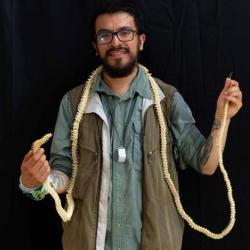Biography
I am a PhD student and Gates Cambridge Scholar in the Vertebrate Paleontology Group at the Department of Zoology. I completed my B.S. in biology (2018) at Universidad de los Andes, Colombia; where I also studied civil engineering (2017).
From 2019 to 2022, I worked as a research assistant at Universidad del Rosario, Colombia; where I developed various research and field work activities at different fossiliferous localities rangind from the Jurassic to Pleistocene. At the same institution, I completed my MSc. in Natural Sciences.
I have been reviewer of the following scientific Journals: Ameghiniana,Comptes Rendus Palevol Scientific Reports and The Anatomical Record.
Research
My doctoral project aims to understand the tempo and mode of diversification of neotropical snakes, especially colubroids. To accomplish this, I will combine new fossil and molecular data with ecological and life history information to reconstruct the origin of modern snake diversity in the neotropics following a phylogenetic and stratigraphic context.
Publications
Vásquez-Restrepo, J. D, Alfonso-Rojas, A., & Palacios-Aguilar, R. (2024). On the validity of the recently described northern green anaconda Eunectes akayima (Squamata, Serpentes). Bionomina, 37(1), 1-7.
Carrillo, J. D., Jaramillo, C., Abadía, F., Aguilera, O., Alfonso-Rojas, A., Billet, G., ... & Zapata, S. (2023). The Miocene La Venta Biome (Colombia): A century of research and future perspectives. Geodiversitas, 45(26), 739 767
Alfonso-Rojas A., Vanegas R. D., Mariño-Morejón E. & Cadena E.-A. (2023). Newly discovered fossils provide novel insights on the biology of the South American Miocene snake Colombophis Hoffstetter & Rage, 1977, in Carrillo J. D. (ed.), Neotropical palaeontology: the Miocene La Venta biome. Geodiversitas 45 (13): 377-399. https://doi.org/10.5252/geodiversitas2023v45a13. http://geodiversitas.com/45/13
Alfonso-Rojas, A., & Cadena, E. A. (2022). The first benthic insects (Ephemeroptera and Coleoptera) from the Upper Cretaceous of Colombia. Cretaceous Research, 105116. https://doi.org/10.1016/j.cretres.2021.105116
Alfonso‐Rojas, A., Herrera‐Gutierrez, L. M., Suárez, C., Ciancio, M. R., Pelegrin, J. S., & Cadena, E. A. (2021). Late Pleistocene biota from Pubenza, Colombia; turtles, mammals, birds, invertebrates and plant remains. Journal of Quaternary Science, 36(3), 450-466. https://doi.org/10.1002/jqs.3299
Alfonso-Rojas, A., & Cadena, E. A. (2020). Exceptionally preserved ‘skin’ in an Early Cretaceous fish from Colombia. PeerJ, 8, e9479. http://dx.doi.org/10.7717/peerj.9479
Teaching and Supervisions
- Supervisor, ZL1 Evolution and Comparative Anatomy of Mammals, University of Cambridge
- Supervisor, ZM1 Vertebrate Evolution, University of Cambridge

